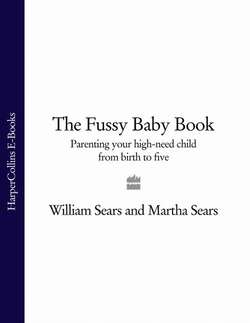Читать книгу The Fussy Baby Book: Parenting your high-need child from birth to five - Martha Sears - Страница 63
don’t panic!
ОглавлениеPatricia, a new mother of a high-need baby, was a psychologist specializing in child development. Because clients with low self-esteem had consumed her counselling days, she was determined that she would bring up her child to have healthy self-esteem. She understood the value of giving a nurturant response to her baby’s cries. But baby Christopher didn’t just cry, he shrieked. Within the first millisecond of Christopher’s shriek, Patricia would jump up, a tense mother with a worried face, inadvertently increasing his tension and sending him into an all-out fit that could have been avoided.
Martha watched this behaviour unfold one day when Patricia was over for a visit. Patricia had come over for Martha’s advice because she couldn’t get Christopher to go into the sling. Each time she tried, Christopher would shriek, and Patricia would panic and quickly end the lesson by grabbing her baby out of the sling and calming him. Martha showed Patricia several ways of positioning Christopher in the sling, and, sure enough, each position was unpopular with Christopher. Patricia would visibly tense up and look worried until Martha suggested another position. Finally, Martha figured out which position worked best for the two of them, and then, although Christopher was beginning to fret, Martha calmly said, “Now let’s go for a walk around the block.” This had two results. Christopher started to relax as Patricia started moving, and Patricia took her mind off the baby for a few minutes.
Martha and Patricia chatted as they walked, and Christopher became more and more relaxed. Soon Patricia was sensing that Christopher was actually enjoying the sling, and they both relaxed even more, so much so that the baby fell asleep. Patricia learned that she could mirror relaxation to her baby by staying calm and walking onward despite the fussing. Christopher needed his mother to set the mood and allow him enough time to follow suit. Patricia discovered that without much effort her baby would catch mum’s mood, and they could relax together.
Don’t let yourself panic at baby’s first squeak. This overreaction relays the message to baby that there really is something to fuss about, and he will usually oblige. For some babies, the quick response will ward off a hysterical cry; for others, it stimulates it. This is why you have to play each cry by ear. As soon as your baby starts to fuss, put on a relaxed “it’s okay” expression as you calmly tend to him. With a baby of four or five months, you can delay your response a minute or so, depending on the time of day and the situation, to see if baby discovers on his own that there is nothing to fuss about. Throughout the day, each episode will need an individual response. I notice a difference between many first-time mothers, who get easily panicked by the first whimper and are hyper-responsive, and seasoned veterans, who take a more relaxed, but still nurturant, approach to responding to baby’s crying.
Giving the right response for each situation is part of being mature as a parent. And guess what? You don’t always have to get it right. Babies are forgiving, and they seem to appreciate that at least you are trying. It’s not your fault that your baby cries; nor is it always your responsibility to keep baby from crying. Your job is to set the conditions to lessen baby’s need to cry and to offer a nurturant response when baby does need to cry. The rest is up to baby.
